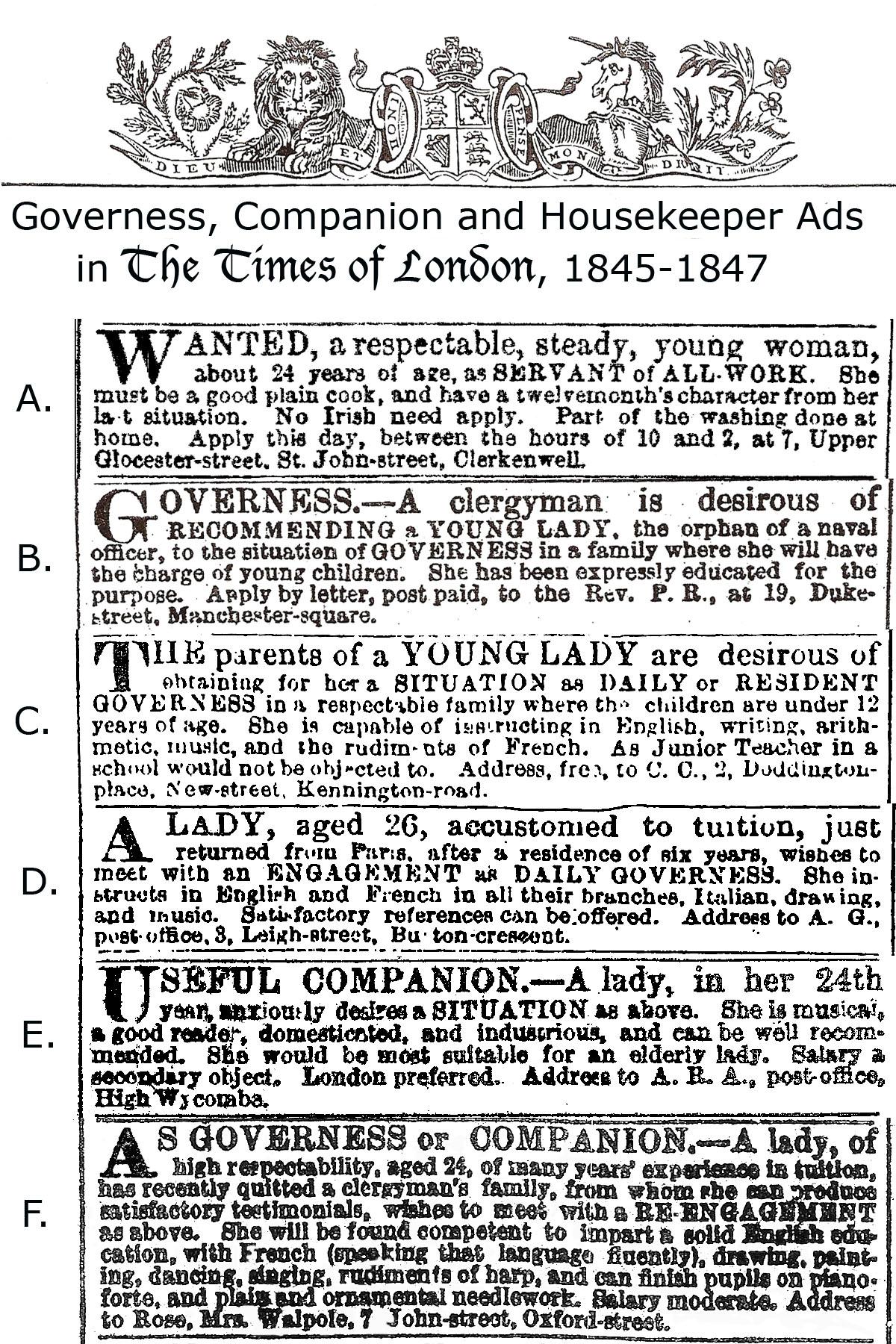As the ads suggest, the term “governess” itself is more ambiguous than most realize. As Jeanne Peterson illustrates, “the term ‘governess’ could refer to a woman who taught in a school, a woman who lived at home and travelled to her employer's house to teach [...], or a woman who lived in her employer's home and who taught the children and served as a companion to them” (4). Essentially, the term governess is an all-encompassing term for almost any woman in education. This ambiguity is a major factor in the plight of the governess. The term itself doesn’t give a clear explanation of the class or status of a governess, leading to a unique position in society where they weren’t “ladies” but they were more respectful than the typical working-class woman—although they were paid like them. This conflict could allow them to have more social mobility, but that could work both ways. It could either raise or lower their position in society. It is for this reason that many governesses sought employment on the continent, where their status was less ambiguous.
Previously, the power structure within Britain had only two classes. By the Victorian Era, the middle class was beginning to expand. Governesses could be considered either upper or middle class in status, while being financially poor. Estrella quotes Esther Godfrey who explains the difficulty that governesses faced: “the corresponding polarization of male and female realms within the middle class can be read as the result of a larger societal anxiety about gender identities that emerged from the instability of working-class gender roles in the new social framework” (qtd. In Estrella 106). In essence, governesses experienced not only polarization in class structures, but also gender roles. Sometimes, moving to the continent or emigrating (usually to Australia) were their best options to experience more freedom. By doing so, governesses experienced fewer societal pressures. On the continent, there were also more opportunities for marriage than in England.
Jane Eyre is among the most famous governesses of all time. Many novels, especially within the Victorian Era have governesses among their principal characters. As discussed in class, Victorian Governesses played an interesting role in society. Violeta Estrella in “Semantic Change and Victorian Governess Fiction” explains the plight of the governess as “the ambiguous status of the Victorian governess, the lady who had to earn her living in a world dominated by the ideology of separate spheres” (Estrella 105). Marian Amies, in “The Victorian Governess and Colonial Ideals of Womanhood” explains that governesses were supposed to be “lad[ies], in every meaning of the word” but they also had “no equals…she is a burden and restraint in society” (Amies 537). These expectations lead governesses to hold a unique position in society where they were neither servants nor lady. Governesses were considered gentlewomen who sought employment. By doing so, they failed to live up to the Victorian ideal of the accomplished, leisurely woman (Amies 538).
In connection to what we have discussed in class, governesses had more social mobility than many women. Jane Eyre is a great example of this. Charlotte Bronte had been a governess herself, and her experiences were reflected in her novel. Amies argues that works like Jane Eyre as “a vehicle to expose the plight of the governess” (Amies 538). However, Jane Eyre is seen as an exception. Later novelists tended more toward stereotypes of the governess. Amies names one of the most prominent stereotypes of that of the “pathetic, downtrodden governess…outside the ideal of leisured womanhood” (538). Women of leisure were the ultimate ideal for the Victorian woman. Governesses, even if they were middle or upper class, could never be women of leisure. They were simply too poor. Jane Eyre experienced this. It was only by becoming an heiress and getting married that she becomes the ideal Victorian woman. As a governess, women were confined to a socially ambiguous position, which would have been very difficult. Not only was their status constantly in question, but they were paid very little. Governesses were dependent on their employers. Jane Eyre was a unique case, in which she became an independent woman in means and raised her social status through her marriage to Rochester. It is only under similar circumstances that governesses were able to break from the social constraints brought on by their profession.
Works Cited
Amies, Marion. “The Victorian Governess and Colonial Ideals of Womanhood.” Victorian Studies, vol. 31, no. 4, July 1988, pp. 537–65. EBSCOhost, discovery.ebsco.com/linkprocessor/plink?id=55402742-51b6-3310-9182-8a9923ff4ee8.
Estrella, Violeta. “Semantic Change and Victorian Governess Fiction.” Professional Communication and Translation Studies, vol. 9, Jan. 2016, pp. 105–14. EBSCOhost, discovery.ebsco.com/linkprocessor/plink?id=7ae76fd8-7463-37cb-8c38-c8d39c8dfd73.
Peterson, M. Jeanne. “The Victorian Governess: Status Incongruence in Family and Society.” Victorian Studies, vol. 14, no. 1, 1970, pp. 7–26. JSTOR, http://www.jstor.org/stable/3826404. Accessed 3 Oct. 2022.


